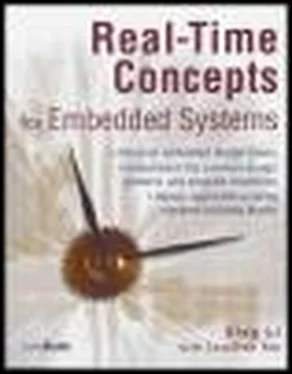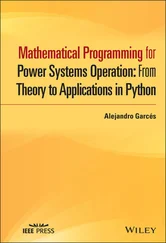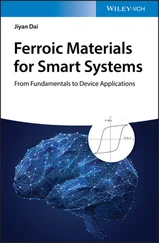13.2.4 The free Operation
Note that the bottom layer of the malloc and free implementation is shown in Figure 13.3 and Figure 13.4. In other words, another layer of software tracks, for example, the address of an allocated block and its size. Let's assume that this software layer exists and that the example is not concerned with it other than that this layer feeds the necessary information into the free function.
The main operation of the free function is to determine if the block being freed can be merged with its neighbors. The merging rules are
1. If the starting index of the block is not 0, check for the value of the array at (index -1). If the value is positive (not a negative value or 0), this neighbor can be merged.
2. If (index + number of blocks) does not exceed the maximum array index value, check for the value of the array at (index + number of blocks). If the value is positive, this neighbor can be merged.
These rules are illustrated best through an example, as shown in Figure 13.5.
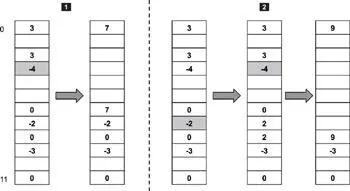
Figure 13.5: The free operation.
Figure 13.5 shows two scenarios worth discussion. In the first scenario, the block starting at index 3 is being freed. Following rule #1, look at the value at index 2. The value is 3; therefore, the neighboring block can be merged. The value of 3 indicates that the neighboring block is 3 units large. The block being freed is 4 units large, so following rule #2, look at the value at index 7. The value is -2; therefore, the neighboring block is still in use and cannot be merged. The result of the free operation in the first scenario is shown as the second table in Figure 13.5.
In the second scenario, the block at index 7 is being freed. Following rule #1, look at the value at index 6, which is 0. This value indicates the neighboring block is still in use. Following rule #2, look at the value at index 9, which is -3. Again, this value indicates that this block is also in use. The newly freed block remains as independent piece. After applying the two merge rules, the next free operation of the block starting at index 3 results in the allocation table shown as the last table in Figure 13.5.
When a block is freed, the heap must be updated accordingly. Therefore, the free operation involves the following steps:
1. Update the allocation array and merge neighboring blocks if possible.
2. If the newly freed block cannot be merged with any of its neighbors, insert a new entry into the heap array.
3. If the newly freed block can be merged with one of its neighbors, the heap entry representing the neighboring block must be updated, and the updated entry rearranged according to its new size.
4. If the newly freed block can be merged with both of its neighbors, the heap entry representing one of the neighboring blocks must be deleted from the heap, and the heap entry representing the other neighboring block must be updated and rearranged according to its new size.
13.3 Fixed-Size Memory Management in Embedded Systems
Another approach to memory management uses the method of fixed-size memory pools. This approach is commonly found in embedded networking code, such as in embedded protocol stacks implementation.
As shown in Figure 13.6, the available memory space is divided into variously sized memory pools. All blocks of the same memory pool have the same size. In this example, the memory space is divided into three pools of block sizes 32, 50, and 128 respectively. Each memory-pool control structure maintains information such as the block size, total number of blocks, and number of free blocks. In this example, the memory pools are linked together and sorted by size. Finding the smallest size adequate for an allocation requires searching through this link and examining each control structure for the first adequate block size.
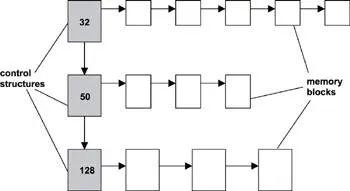
Figure 13.6: Management based on memory pools.
A successful allocation results in an entry being removed from the memory pool. A successful deallocation results in an entry being inserted back into the memory pool. The memory pool structure shown in Figure 13.6 is a singly linked list. Therefore, memory allocation and deallocation takes place at the beginning of this list.
This method is not as flexible as the algorithm introduced earlier in 'Dynamic Memory Allocation in Embedded Systems' on page 200 and also has some drawbacks. In real-time embedded systems, a task's memory requirement often depends on its operating environment. This environment can be quite dynamic. This method does not work well for embedded applications that constantly operate in dynamic environments because it is nearly impossible to anticipate the memory block sizes that the task might commonly use. This issue results in increased internal memory fragmentation per allocation. In addition, the number of blocks to allocate for each size is also impossible to predict. In many cases, the memory pools are constructed based on a number of assumptions. The result is that some memory pools are under used or not used at all, while others are overused.
On the other hand, this memory allocation method can actually reduce internal fragmentation and provide high utilization for static embedded applications. These applications are those with predictable environments, a known number of running tasks at the start of application execution, and initially known required memory block sizes.
One advantage of this memory management method is that it is more deterministic than the heap method algorithm. In the heap method, each malloc or free operation can potentially trigger a rearrangement of the heap. In the memory-pool method, memory blocks are taken or are returned from the beginning of the list so the operation takes constant time. The memory pool does not require restructuring.
13.4 Blocking vs. Non-Blocking Memory Functions
The malloc and free functions do not allow the calling task to block and wait for memory to become available. In many real-time embedded systems, tasks compete for the limited system memory available. Oftentimes, the memory exhaustion condition is only temporary. For some tasks when a memory allocation request fails, the task must backtrack to an execution checkpoint and perhaps restart an operation. This issue is undesirable as the operation can be expensive. If tasks have built-in knowledge that the memory congestion condition can occur but only momentarily, the tasks can be designed to be more flexible. If such tasks can tolerate the allocation delay, the tasks can choose to wait for memory to become available instead of either failing entirely or backtracking.
For example, the network traffic pattern on an Ethernet network is bursty. An embedded networking node might receive few packets for a period and then suddenly be flooded with packets at the highest allowable bandwidth of the physical network. During this traffic burst, tasks in the embedded node that are in the process of sending data can experience temporary memory exhaustion problems because much of the available memory is used for packet reception. These sending tasks can wait for the condition to subside and then resume their operations.
In practice, a well-designed memory allocation function should allow for allocation that permits blocking forever, blocking for a timeout period, or no blocking at all. This chapter uses the memory-pool approach to demonstrate how to implement a blocking memory allocation function.
As shown in Figure 13.7, a blocking memory allocation function can be implemented using both a counting semaphore and a mutex lock. These synchronization primitives are created for each memory pool and are kept in the control structure. The counting semaphore is initialized with the total number of available memory blocks at the creation of the memory pool. Memory blocks are allocated and freed from the beginning of the list.
Читать дальше
